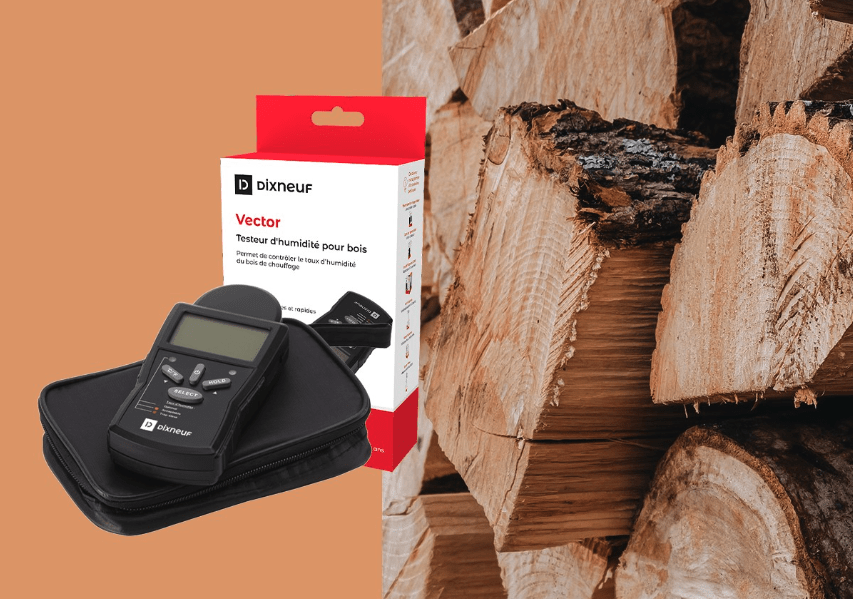
What is optimal combustion?
Optimal combustion depends on several key factors.
Immediate and efficient ignition
If you place a damp log into your fireplace, the first thing it does is attempt to dry out, which delays combustion and causes several issues. Ideally, the wood should quickly form embers that release heat efficiently.
Efficiency also means protecting your equipment: poor combustion caused by damp wood will clog your system over time, reducing heat output. In models with glass doors, the screen darkens, and flue diameter narrows due to soot build-up. For environmental reasons, dry wood is essential – it emits up to four times less CO₂ than wet wood, leading to cleaner air.
Cost-effective combustion
Optimal combustion burns slowly, requiring fewer refuels. Damp wood that doesn’t ignite properly tempts you to add more logs in an attempt to keep the fire going. But for efficient combustion, choose high-quality hardwoods (e.g. hornbeam, holm oak, white oak, beech) and ensure their moisture content is under 20%.
Many sources agree: wet wood provides half the energy output of the same volume of dry wood. To achieve the same heat, you’d need to double the fuel, which is neither economical nor sustainable.
Eco-friendly combustion
Wood is a renewable energy source with a carbon footprint considered neutral, but only if its combustion releases no more CO₂ than the tree absorbed during its life through photosynthesis. This balance can only be achieved when the wood burns completely.
What are the risks of incomplete combustion?
Burning damp or poorly seasoned wood can lead to several issues.
Soot build-up
Burning damp wood causes soot to accumulate inside your stove and flue, obstructing airflow and posing a serious fire risk.
Reduced energy efficiency
Incomplete combustion lowers the overall performance of your heating system and reduces the savings you might expect.
Increased pollutant emissions
Using damp logs leads to a poor burn and produces more harmful gases. Sub-optimal combustion releases substances like carbon monoxide, hydrogen sulphide, and fine particles. Besides the risks these pose to your health (it is strongly advised to install a carbon monoxide detector, as only smoke detectors are legally required), poor combustion also contributes to air pollution.
How to maximise the efficiency of your heating system by controlling wood moisture
Keeping wood moisture in check is key to efficient heating.
Storage
Just received a delivery of firewood and unsure how to store it to keep it dry?
Pick a sheltered but well-ventilated area.
Then stack the logs in a neat pile.
These precautions allow for proper airflow and create ideal conditions for drying your firewood.
How to measure moisture
Unless water is visibly running down your walls, it is hard to know the exact humidity in your home – let alone in the wood you’re about to burn.
Some physical clues indicate dry wood (lighter weight, visible cracks, paler colour), but only precise measurement provides certainty.
According to the National Forests Office (ONF), the standard method for measuring firewood moisture is to dry it in an oven at 105°C until it reaches a constant weight (usually between seven and 24 hours).
The moisture level is then calculated by comparing the weight before and after drying.
While effective, this is impractical at home – whereas moisture meters offer reliable results without specialised equipment.
The benefits of a wood moisture meter
This compact, easy-to-use device gives you the ability to check wood moisture both when you buy it (since dry wood commands a higher price only if its moisture level is genuinely below 23%) and just before use.
A moisture meter – or hygrometer – allows you to rely on accurate data.
With it, you can assess the quality and value of your firewood, verify the effectiveness of your storage solution, and confirm your wood is dry enough for clean, efficient burning.
Discover the Vector, the moisture tester designed by Dixneuf, France’s leading manufacturer of stove and fireplace accessories. Find our Vector hygrometer through our network of trusted retail partners.